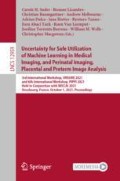Abstract
We introduce an uncertainty-aware deep learning deformable image registration solution for magnetic resonance imaging multi-channel data. In our proposed framework, the contributions of structural and microstructural data to the displacement field are weighted with spatially varying certainty maps. We produce certainty maps by employing a conditional variational autoencoder image registration network, which enables us to generate uncertainty maps in the deformation field itself. Our approach is quantitatively evaluated on pairwise registrations of 36 neonates to a standard structural and/or microstructural template, and compared with models trained on either single modality, or both modalities together. Our results show that by incorporating uncertainty while fusing the two modalities, we achieve superior alignment in cortical gray matter and white matter regions, while also achieving a good alignment of the white matter tracts. In addition, for each of our trained models, we show examples of average uncertainty maps calculated for 10 neonates scanned at 40 weeks post-menstrual age.
Access this chapter
Tax calculation will be finalised at checkout
Purchases are for personal use only
References
Avants, B., Duda, J.T., Zhang, H., Gee, J.C.: Multivariate normalization with symmetric diffeomorphisms for multivariate studies. In: Ayache, N., Ourselin, S., Maeder, A. (eds.) MICCAI 2007. LNCS, vol. 4791, pp. 359–366. Springer, Heidelberg (2007). https://doi.org/10.1007/978-3-540-75757-3_44
Balakrishnan, G., Zhao, A., Sabuncu, M.R., Guttag, J., Dalca, A.V.: VoxelMorph: a learning framework for deformable medical image registration. IEEE Trans. Med. Imaging 38(8), 1788–1800 (2019)
Barnett, M.L., et al.: Exploring the multiple-hit hypothesis of preterm white matter damage using diffusion MRI. NeuroImage: Clin. 17, 596–606 (2018)
Christiaens, D., et al.: Scattered slice SHARD reconstruction for motion correction in multi-shell diffusion MRI. NeuroImage 225, 117437 (2021). https://doi.org/10.1016/j.neuroimage.2020.117437
Cordero-Grande, L., Hughes, E.J., Hutter, J., Price, A.N., Hajnal, J.V.: Three-dimensional motion corrected sensitivity encoding reconstruction for multi-shot multi-slice MRI: Application to neonatal brain imaging. Magn. Reson. Med. 79(3), 1365–1376 (2018)
Dalca, A.V., Balakrishnan, G., Guttag, J., Sabuncu, M.R.: Unsupervised learning for fast probabilistic diffeomorphic registration. In: Frangi, A.F., Schnabel, J.A., Davatzikos, C., Alberola-López, C., Fichtinger, G. (eds.) MICCAI 2018. LNCS, vol. 11070, pp. 729–738. Springer, Cham (2018). https://doi.org/10.1007/978-3-030-00928-1_82
Forsberg, D., Rathi, Y., Bouix, S., Wassermann, D., Knutsson, H., Westin, C.-F.: Improving registration using multi-channel diffeomorphic demons combined with certainty maps. In: Liu, T., Shen, D., Ibanez, L., Tao, X. (eds.) MBIA 2011. LNCS, vol. 7012, pp. 19–26. Springer, Heidelberg (2011). https://doi.org/10.1007/978-3-642-24446-9_3
Hughes, E.J., et al.: A dedicated neonatal brain imaging system. Magn. Reson. Med. 78(2), 794–804 (2017)
Hutter, J., et al.: Time-efficient and flexible design of optimized multishell HARDI diffusion. Magn. Reson. Med. 79(3), 1276–1292 (2018)
Kingma, D.P., Rezende, D.J., Mohamed, S., Welling, M.: Semi-supervised learning with deep generative models (2014). https://arxiv.org/abs/1406.5298
Krebs, J., Mansi, T., Mailhé, B., Ayache, N., Delingette, H.: Unsupervised probabilistic deformation modeling for robust diffeomorphic registration. In: Stoyanov, D., et al. (eds.) DLMIA/ML-CDS -2018. LNCS, vol. 11045, pp. 101–109. Springer, Cham (2018). https://doi.org/10.1007/978-3-030-00889-5_12
Kuklisova-Murgasova, M., Quaghebeur, G., Rutherford, M.A., Hajnal, J.V., Schnabel, J.A.: Reconstruction of fetal brain MRI with intensity matching and complete outlier removal. Med. Image Anal. 16, 1550–1564 (2012)
Makropoulos, A., Gousias, I.S., Ledig, C., Aljabar, P., Serag, A., Hajnal, J.V., Edwards, A.D., Counsell, S.J., Rueckert, D.: Automatic whole brain MRI segmentation of the developing neonatal brain. IEEE Trans. Med. Imaging 33(9), 1818–1831 (2014)
Rueckert, D., Sonoda, L.I., Hayes, C., Hill, D.L.G., Leach, M.O., Hawkes, D.J.: Nonrigid registration using free-form deformations: application to breast MR images. IEEE Trans. Med. Imaging 18(8), 712–721 (1999)
Schuh, A., et al.: Unbiased construction of a temporally consistent morphological atlas of neonatal brain development. bioRxiv (2018)
Tournier, J.D., et al.: MRtrix3: a fast, flexible and open software framework for medical image processing and visualisation. NeuroImage 202, 116137 (2019)
Uus, A., et al.: Multi-channel 4D parametrized atlas of macro- and microstructural neonatal brain development. Front. Neurosci. 15, 721 (2021). https://doi.org/10.3389/fnins.2021.661704
Xu, B., Wang, N., Chen, T., Li, M.: Empirical evaluation of rectified activations in convolutional network (2015). https://arxiv.org/abs/1505.00853
Acknowledgments
This work was supported by the Academy of Medical Sciences Springboard Award [SBF004\(\backslash \)1040], Medical Research Council (Grant no. [MR/K006355/1]), European Research Council under the European Union’s Seventh Framework Programme [FP7/20072013]/ERC grant agreement no. 319456 dHCP project, the EPSRC Research Council as part of the EPSRC DTP (grant Ref: [EP/R513064/1]), the Wellcome/EPSRC Centre for Medical Engineering at King’s College London [WT 203148/Z/16/Z], the NIHR Clinical Research Facility (CRF) at Guy’s and St Thomas’, and by the National Institute for Health Research Biomedical Research Centre based at Guy’s and St Thomas’ NHS Foundation Trust and King’s College London.
Author information
Authors and Affiliations
Corresponding author
Editor information
Editors and Affiliations
Rights and permissions
Copyright information
© 2021 Springer Nature Switzerland AG
About this paper
Cite this paper
Grigorescu, I. et al. (2021). Uncertainty-Aware Deep Learning Based Deformable Registration. In: Sudre, C.H., et al. Uncertainty for Safe Utilization of Machine Learning in Medical Imaging, and Perinatal Imaging, Placental and Preterm Image Analysis. UNSURE PIPPI 2021 2021. Lecture Notes in Computer Science(), vol 12959. Springer, Cham. https://doi.org/10.1007/978-3-030-87735-4_6
Download citation
DOI: https://doi.org/10.1007/978-3-030-87735-4_6
Published:
Publisher Name: Springer, Cham
Print ISBN: 978-3-030-87734-7
Online ISBN: 978-3-030-87735-4
eBook Packages: Computer ScienceComputer Science (R0)


